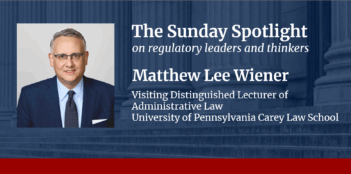
An arts-based framework could re-democratize the rulemaking process.
Public participation is one of the cornerstones of U.S. administrative law, and perhaps nothing better exemplifies its value than the notice-and-comment rulemaking process through which stakeholders can provide input on a proposed rule. Yet there remains an inherent tension in the democratic potential of this process. In reviewing final rules, courts demand that agencies demonstrate that those rules are responsive to any substantive comments they receive. But courts generally limit this requirement to comments containing legal or technical information.
This approach to judicial supervision of agency rulemaking is just one of many forces that have helped transform what should be a democratic rulemaking process into a technocratic exercise. On the plus side, expertise-centered rulemaking has substantially improved regulatory quality. These gains, however, have come with some important unintended consequences.
For one, the growing hegemony of technocratic decision-making dehumanizes the rulemaking process, resulting in an process that is unmoored from authentic human experiences—pain, hope, fear, loss—and from shared values like dignity, fairness, and justice. Worse still, overly technocratic rulemaking reinforces existing social inequalities by systematically excluding the voices of those who cannot “buy” the kind of specialized legal or technical expertise that holds sway with agency decision-makers. All too often, these voices belong to the members of the communities most impacted by the harms a regulation is meant to address. These individuals have acquired direct knowledge of these problems through their lived experience but rarely have the means to translate it into technocratic language.
In contrast, the entities with sufficient resources to overcome administrative law’s doctrinal barriers to meaningful participation in the rulemaking process tend to be corporations (along with the trade associations, advocacy organizations, and think tanks they financially support) that are the focus of regulations. The practical result is that these doctrines end up privileging the perspective of the regulated community. This skewed perspective in turn risks producing decisions that give short shrift to the public interest, a result directly at odds with the goals of the authorizing statutes.
So how can we make the voices of ordinary Americans heard in the rulemaking process in a way that does not punish them for lacking law degrees or PhDs? Can we imagine a rulemaking process that not only invites but weighs the lived experiences of Americans who are more comfortable with hip hop music or street art than with legal briefs or dose-response curves? How can we capture their experiences about air pollution or predatory loans?
Art offers several unique advantages for re-democratizing the rulemaking process, especially those art forms that might be thought of as folk art, which are characterized by their authenticity, universal accessibility, and distinct cultural significance. Whether captured in the medium of visual arts, music, or literature, folk art is generally available for everyone’s use and is readily understandable to all. It has the capacity not just to convey valuable information, but to establish meaningful connections between the artist and audience, even if they come from highly disparate backgrounds.
Among folk art forms, hip hop is especially important for some of the most marginalized members of our society. For African Americans, members of lower-income, urban communities, and others, hip hop has long provided a powerful means for social and political commentary. But why stop there? One can imagine someone from the upper Midwest writing a graphic novel depicting how agricultural pollution has tainted her community’s drinking water. Or to illustrate how rights to access justice in the courts have been curtailed, someone from suburban Oklahoma might create a collage comprising the dozens of forced arbitration agreements to which he is subject.
Incorporating hip hop and other forms of art into the rulemaking process could be as simple as agencies explicitly inviting submissions through their standard notices of proposed rulemaking. Modern technology should make it relatively easy for agencies to accept submissions in a wide variety of audio and visual formats. Those materials could thus become part of the relevant rulemaking docket.
To help organize the process, agencies could hire artists to compile the submissions into anthologies or even to create original artwork that draws upon the public submissions. These materials could be discussed as part of the preamble to the final rule and, if applicable, would be available for judges to consider during judicial review.
Precedent for these activities can be found in the New Deal-era Federal Writers’ Project. As Naomi Klein explains, one of the purposes of this and other Works Progress Administration-sponsored art programs was to “mirror a shattered country back to itself and in the process, make an unassailable case for why New Deal relief programs were so desperately needed.” Likewise, art can help make the case for why we need to clean up air pollution in urban areas or to protect consumers against forced arbitration agreements.
I recommend calling the rulemaking art anthologies a “people’s regulatory impact analysis” because they would perform a function similar to that of the current regulatory impact analyses that executive branch agencies already conduct. According to their supporters, these existing analyses provide valuable information about a regulation’s likely economic impacts and help guide an agency’s use of discretion within the boundaries of its legal authority.
A people’s regulatory impact analysis could do even more by providing an important counterweight to agencies’ current form of regulatory impact analysis. Whereas these current cost-benefit analyses dehumanize the people who regulations are meant to help by reducing them to unrecognizable dollars-and-cents abstractions, a people’s regulatory impact analysis would build up and validate the lived experience of real people by sharing their stories in their own words.
The use of people’s regulatory impact analyses should find support across the political spectrum. For conservatives, it would answer their (inaccurate) claim that so-called “bureaucrats” are out of touch with real Americans. For progressives, it would align with their proposals to enhance meaningful opportunities for public participation in the rulemaking process. Given its New Deal provenance, the practice of allowing for a people’s regulatory impact analysis would also fit within the vision laid out in the Green New Deal.
Administrative law experts have long recognized the essential role that public participation plays in the rulemaking process. People’s regulatory impact analyses promise to breathe new life into these principles without displacing the contributions of technocratic expertise in regulatory decision-making.




